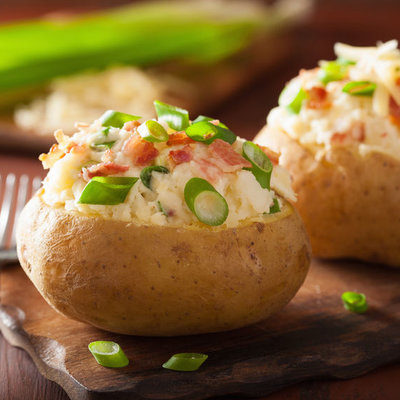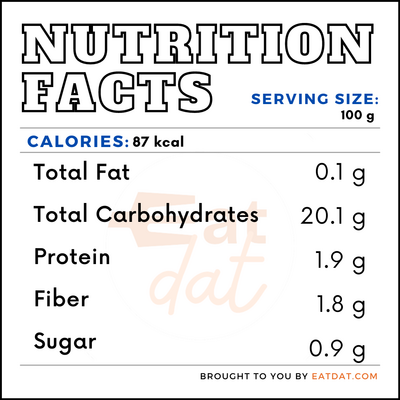
Potato
What is a Potato?
The potato is a starchy root vegetable from the Solanacae family. It is one of the most popular food crops in the world and is especially essential in Europe.
The six common types of this vegetable are:
- Russet
- Yellow
- Red
- White
- Blue
- Fingerling
In 2018, the worldwide production of this crop totaled 368 million metric tons. There are more than 200 varieties of this vegetable sold in the US. The average American consumes 140 pounds of this vegetable annually.
Origin of potatoes
This vegetable has its origin in the Andean highlands between Peru and Bolivia. Humans in this region domesticated wild varieties of this crop around 8,000-7,000 BC, after which it spread across the South American continent. This vegetable attracted Spanish conquistadors when they were searching Peru for gold in the 1530s. These Europeans brought this plant back to Europe between 1570 and 1593. The Spanish government later transported potatoes to their military due to the food’s reliability.
For years, people in Europe saw this vegetable as a cause of disease and bad luck. This sentiment reduced when France was looking for a solid food source for their military. Antoine-Augustin Parmentier, a French chemist, persuaded the King of France, Louis XVI, to encourage large-scale production of the crop. The king gave Parmentier funds, guards, and 100 acres of land to grow the vegetable. People slowly began to change their opinions when they saw the kind of attention given to this root vegetable.
Eventually, people started adopting this crop more and more until it became a massive food source in Europe. This vegetable became a popular food in Europe in the early 18th century. The USA was the last major country to accept this food. For many years, Americans saw it as only food for horses. Today, this food remains one of the most popular foods anywhere on the globe.
Nutrition
In 100g of boiled potatoes (cooked with the skin), there are:

This food has several significant health benefits:
- This vegetable contains compounds that can help to lower blood pressure.
- It can help with weight loss and weight management.
- This vegetable can be instrumental in maintaining the blood sugar level.
- It contains varying amounts of resistant starch which improves digestive health.
Nonetheless, this vegetable also has its side effects:
- People might have an allergy to this food. However, this syndrome is rare.
- When fried, this crop is bad for people who have cardiovascular diseases, obesity, or diabetes.
Commercial production
It is possible to grow potatoes on any type of soil except saline and alkaline soils. A pH value between 5.2 and 6.4 is ideal for the production of this vegetable. The land must be adequately tilled and prepared before any cultivation takes place and for farmers to cultivate disease-free potatoes from their tubers. Regular weed control and fertilizer application have their place in the growth of this healthy crop. These plants are ripe for harvesting when their leaves become yellow.
Application
Raw potatoes can survive for months if stored at a temperature between 42.8-50°F. It’s vital to keep them away from light, as this can make them green and toxic. Also, they should never be stored in the freezer or refrigerator, instead they should be placed in an open bowl with proper ventilation.
It’s recommendable not to wash this vegetable before storing it to prevent the growth of bacteria. Additionally, you should cook this crop, if it’s raw or sliced, within a day. When you want to buy this vegetable, choose those that are smooth and free of bruises.
Potato recipes
There are many ways to prepare this delicious vegetable. Here are some of them:
FDA regulation
The Food and Drug Administration classifies this root vegetable as a raw agricultural product and regulates its growing, harvesting, and packing. The FDA also has a standard of identity for canned potatoes and canned sweet potatoes. They define them as a canned vegetable obtained from the preparation of the succulent potato tuber or sweet potato plant. There are also guidelines on how these foods should be processed, packaged, and labeled. The FDA even has a standard of identity for potato chips or food prepared from this vegetable when dehydrated.
References
Julson, Erica. “What’s the Best Way to Store Potatoes?” healthline.com, Healthline Media, 12 May 2018, www.healthline.com/nutrition/how-to-store-Potatoes.
Arnarson, Atli. “Potatoes 101: Nutrition Facts and Health Effects.” Healthline.com, Healthline Media, 7 Mar 2019, www.healthline.com/nutrition/foods/Potatoes.
“CFR – Code of Federal Regulations, Title 21.” Accessdata.fda.gov, U.S Food & Drug Administration, 1 Apr. 2019, www.accessdata.fda.gov/scripts/cdrh/cfdocs/cfcfr/CFRSearch.cfm?fr=155.200.
